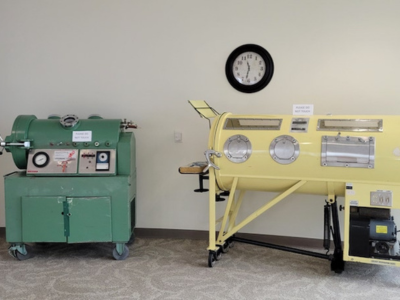
Currently on display outside the Special Collections Room on the 3rd floor of the Strauss Health Sciences Library is a J.R. Emerson Co. Iron Lung (circa 1950s) and a Bethlehem Corporation manufactured infant-sized hyperbaric chamber.
Iron Lung: When incidents of poliomyelitis (polio) began to rise to epidemic proportions in the first half of the 20th century, researchers looked to technology for a way to keep these patients alive. In 1928, Harvard University’s Drs. Philip Drinker and Louis Agassiz Shaw developed the first “iron lung,” a mechanical life-support apparatus that helped a person breathe when their lung muscles were not functioning normally. The machine used External Negative Pressure Ventilation (ENPV). With a patient sealed in the machine, the bellows sucked air out of the box, and as the air pressure dropped, the patient’s lungs automatically expanded and drew fresh air into the diaphragm. When the bellows allowed air back into the box, the air pressure rose, and the patient's lungs deflated, pushing air out of them. Over the next three decades, Drinker’s design evolved, and models like the Emerson Iron Lung, became more lightweight, portable, and less expensive. By the 1950s, more than 12,000 patients relied on iron lungs for their survival, and throughout the polio epidemic, they saved thousands of people from dying. Today, thanks to widespread vaccination worldwide, polio has mostly been eradicated, and modern-day ventilators have replaced earlier respirators. As of 2024, only one person in the United States still uses an iron lung.
Hyperbaric Chamber: Different from an iron lung in design and function, a hyperbaric chamber is an enclosure wherein the air is raised to a level that is higher than normal air pressure. The increased air pressure in the chamber helps the body’s lungs and tissues collect more oxygen to heal and fight infection. British clergyman Nathaniel Henshaw developed his “Domicilium” in 1662 which represents the first use of hyperbaric medicine. Despite lacking any scientific basis for his theories, Henshaw intuited that increased air pressure might alleviate acute injuries, while lower pressures might be useful with chronic pathologies. A century later in 1774, Joseph Priestly discovered oxygen, and two to three centuries later the benefits of hyperbaric oxygen therapy (HBOT) began to be scientifically tested. Today, there are more than 500 HBOT facilities in the U.S., including at UCHealth, that are used for a variety of medical purposes, including treating certain types of wounds, carbon monoxide poisoning, and decompression sickness (or “the bends”).
The iron lung and hyperbaric chamber on display were discovered by staff of the School of Public Health in the basement of the Fitzsimmons building and will be on loan to the library until further notice.
